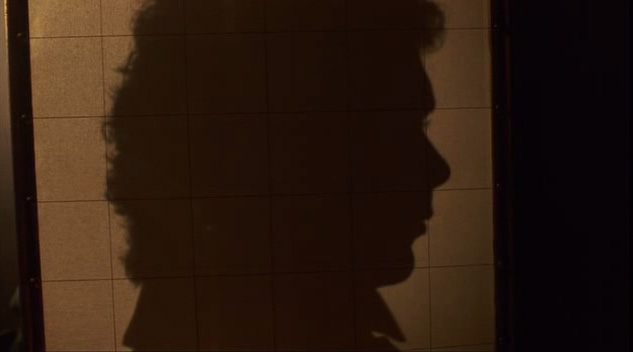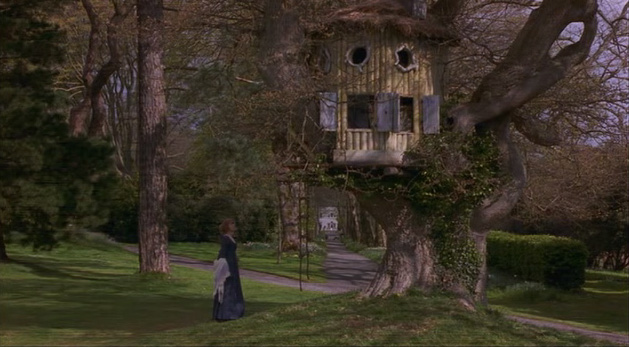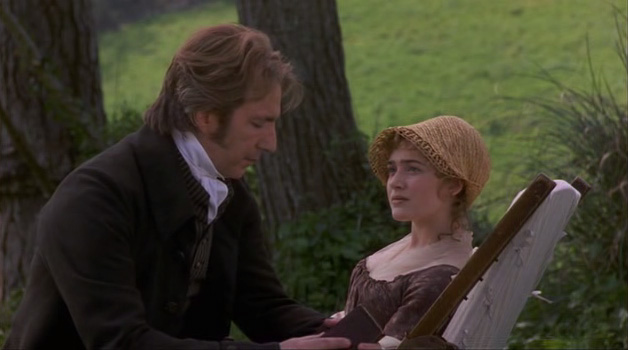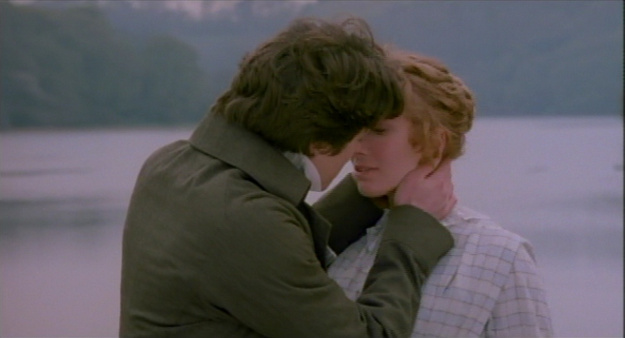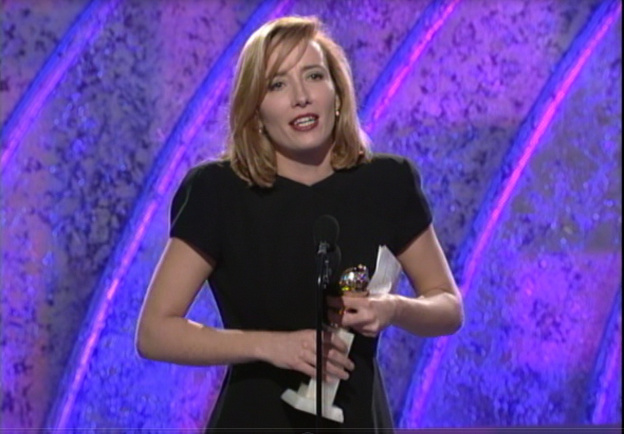|
emma Thompson’s 1995 film adaptation of Sense and Sensibility was applauded by critics, viewers, and the Academies: it won both an Academy Award and a Golden Globe for the Best Adapted Screenplay.1 Film critics have waxed eloquent in praise of Thompson’s adaptation: Sue Parrill judges that “[w]ith a sterling screenplay, a high-powered cast, a talented director, and a delightful soundtrack, this film is a winner in all respects” (24). Exploring Thompson’s adaptation can highlight differences between page and screen. It can also illuminate Austen’s text and the change in sensibilities between Regency and modern societies. The journal Thompson kept during filming, reproduced in Jane Austen’s Sense and Sensibility: The Screenplay and Diaries by Emma Thompson (1995), reveals the challenges of adapting Austen and the methods Thompson employed for overcoming them. Adapting a novel for the screen involves translating a purely linguistic medium to a primarily visual one. Moreover, contemporary moviegoers demand greater romantic appeal from films, especially Austen adaptations, than do readers of books.
Bridging the historical gap is a major challenge for any adapter of Austen. “The process of adaptation, like any reading,” Penny Gay asserts, “demands a recognition of the historical distance between the original text and its new audience. The challenge for filmmakers is to find the visual language and a reading of the original that allow the story to speak to that new audience” (108). Linda Hutcheon argues that adaptation may “keep that prior work alive, giving it an afterlife it would never have had otherwise,” for “adaptation is how stories evolve and mutate to fit new times and different places” (176). Emma Thompson’s adaptation extends the audience for Austen’s 1811 novel into the new millennium through the skilful translation of page to screen.
Such translation involves artistic alchemy. “Adapting is a bit like redecorating,” comments American playwright Alfred Uhry (qtd. in Hutcheon v), but Thompson’s renovation is more radical than those words imply. Thompson’s script is not simply an adaptation of the novel, Penny Gay insists, “but a reworking into a different textual form of material supplied by Jane Austen” (91). Essentially, adapting a novel as a movie means rewriting it in dramatic form as a play. “The content of a movie is a novel or a play or opera,” declares Marshall McLuhan (qtd. in Hutcheon v). Kate Bowles faults Thompson for “displacing [Austen’s] withering authorial tone with dialogue” (15), but adapting fiction to stage or screen must replace narrative with dramatic dialogue. Sense and Sensibility is a thoughtful novel that relies heavily on omniscient narration, but Thompson wisely eschews voice-over, availing herself of Austen’s dialogue, while also dramatizing scenes that are merely recounted in the novel. For example, whereas in the novel Marianne simply complains about the “‘spiritless’” (SS 17) style of Edward’s reading, Thompson dramatizes the scene in which he reads a poem by William Cowper (“The Castaway” in the film).2 Thompson also invents a scene in which Marianne and Willoughby read Shakespeare’s Sonnet 116, “Let me not to the marriage of true minds” (Screenplay 97). After Willoughby jilts her, a tearful Marianne is filmed repeating the sonnet mournfully while gazing down on Combe Magna.
Translating page to screen highlights visual elements, and Austen’s lively dialogue is augmented by the visual language that cinema allows, for a picture is worth a thousand words—unless they’re Jane Austen’s, of course. Visual clues are crucial in a story involving secrets. Strangely, Thompson omits both Edward’s letter that Lucy Steele pointedly displays to Elinor and his miniature, replacing them with a handkerchief embroidered with the initials “E.C.F.” that we see first in Elinor’s and later in Lucy’s hands (Screenplay 126). Thompson also omits the ring with the lock of Lucy’s hair that Elinor ironically mistakes for her own—a clue to the mystery of Edward’s reserved behavior that Elinor’s wishful thinking leads her to misinterpret. This telling detail leads to Edward’s deliberate lie and to Elinor’s assumption that it “must have been procured by some theft or contrivance unknown to herself” (SS 98)—making the ring a symbol of Edward’s deviousness. Thompson probably omitted the ring because she wished to make Edward more appealing to the audience.
Thompson also visualizes scenes to highlight the erotic aspect of Marianne and Willoughby’s relationship, which contrasts strongly with Elinor and Edward’s reserved relationship. For example, she visualizes the report Margaret narrates to Elinor regarding Willoughby’s begging a lock of Marianne’s hair—an intimate scene that naturally leads Margaret to deduce, “‘I am sure they will be married very soon’” (SS 60)—in a romantic vignette (Screenplay 103). She also invents a scene where Marianne sketches Willoughby’s profile (Screenplay 102): “Willoughby’s profile behind the screen is effectively erotic” (Diaries 268), Thompson observes in her journal. Emma Thompson’s own romance with actor Greg Wise during filming may have influenced the erotic manner in which she portrays Willoughby.
Bridging the linguistic and cultural chasm between Austen’s Regency reader and Thompson’s millennial viewer was a major challenge. Thompson was most torn between remaining true to the text and being intelligible to a contemporary audience. “The language in the novel is complex and far more arcane than in the later books,” she notes: “In simplifying it I’ve tried to retain the elegance and wit of the original and it’s necessarily more exacting than modern speech” (Diaries 252). Whenever an actor objected to an utterance, such as Mr. Palmer’s “‘Don’t palm all your abuses of language upon me’” (SS 113), Thompson would retort smugly, “It’s in the book!” (Diaries 249). Producer Lindsay Doran chose Emma Thompson as screenwriter because she knew she would not be too reverential towards the original text. Nevertheless, Austen’s genius is certainly not lost in translation.
The cultural gap between the Regency audience and the millennial one was significant. Thompson credits Executive Producer Sidney Pollack for asking all the right questions: “He wanted to know why Elinor and Marianne couldn’t just go out and get a job. Why was Edward so dependent on his mother, why he keeps his promise to Lucy when he clearly no longer loves her. Why Elinor keeps her promise to Lucy and does not reveal the engagement even to Marianne” (Diaries 265). Pollack reassured Thompson, “I’m from Indiana. . . . [I]f I get it, everyone gets it” (265). Clearly, not everyone “got” it: one producer’s executive secretary responded, “Sense or what?” Ironically, some people assumed that Thompson interjected the matter of Colonel Brandon’s ward’s illegitimate child to spice up the plot for a contemporary audience.
In order to bridge the cultural gap, Thompson employs Margaret as the voice of the audience to ask questions the viewer would like to ask, giving her opportunities to explain Regency manners and morals to a modern audience. Many of these questions have to do with issues of gender. For example, Thompson invents the tree house scene wherein Elinor defines primogeniture to Margaret to explain why they must abandon their home to John and Fanny Dashwood: “Because houses go from father to son, dearest—not from father to daughter. It is the law” (Screenplay 34).
Thompson emphasizes Austen’s feminist satire on Regency gender economics. Graham Fuller opines, “Sense and Sensibility was Austen’s sourest look at the oppression of women through marriage, property and family” (20). In order to convey the idea that “Women had no status except through marriage” (Commentary), Thompson portrays Elinor and Edward discussing his possible professions as she voices her frustration at the lack of options for women: “You talk of feeling idle and useless—imagine how that is compounded when one has no choice and no hope whatsoever of any occupation.” Edward replies, “Our circumstances are therefore precisely the same,” but Elinor retorts, “Except that you will inherit your fortune. We cannot even earn ours” (Screenplay 49). Thus, Thompson emphasizes the economic plight of the Dashwood sisters in particular and women of Austen’s era in general.
Adapting Austen’s Regency characters for a contemporary film audience was the major challenge. Thompson ruminates about Georgian manners and morals, especially those of the responsible characters, so foreign to today’s viewers:
The probity of these people is difficult to accept sometimes—but it is balanced with behaviour of quite the opposite kind from Fanny, Lucy and Willoughby. Elinor and Edward seem both to belong to the eighteenth century, the age of Augustan reason. They are firm, balanced, judgmental, drily humorous, far more Alexander Pope than Walter Scott. Marianne shoots towards the middle of the nineteenth century, embracing each romantic ideal like a new lover. (Diaries 265)
Here she delineates the dichotomy in the cast of characters, as Austen contrasts the “Goodies”—those whose manners reflect their morals accurately—with the “Baddies”—the opportunistic characters whose plausible manners mask their grasping natures. She also defines the cultural dichotomy between Elinor and Marianne, as the sensible Elinor harks back to the Age of Reason while the impetuous Marianne represents the new Romantic Age, with its reverence for nature and spontaneity. Thompson reflects, “The turn of a century seems always to produce a Janus-like generation, some clinging to old systems, some welcoming the new age. A powerful time.”
For Director Ang Lee “the yin and yang” of the story is epitomized in the sisters’ relationship (Diaries 222). Thompson affirms, “It’s a love story between the two sisters” (Commentary), a view taken by some recent critics. “The film embodies the dialectic between Elinor’s rationality and the romantic cult of sensibility espoused by her sister Marianne,” Fuller observes, claiming that Elinor’s “sense” is essential for “female survival under an oppressive patriarchy.” Thompson agrees: “When the father died, Elinor took on that mantle [as] the head of the household” (Commentary).3 Indeed, Elinor’s responsible behavior as she cautions her mother and Marianne against their tendency to extravagance suggests the attitude of a paterfamilias. Fuller declares that Thompson is “Sense and Sensibility’s auteur, its suffragette and heroic ‘male’ surrogate.” Because the male characters are weak, the women must become strong.
In modernizing the script for a contemporary audience, Thompson emphasizes the inherently feminist sentiments of Austen’s novel. Her “late twentieth-century liberal feminism informs” the script, as Gay affirms: “Thompson writes the script of the film Sense and Sensibility as a late twentieth century, English, middle-class, Cambridge-educated feminist” (90, 92). Comparing her own turn of the century feminism to Austen’s, Thompson muses, “As for 1995, hm. Difficult times. Everything more confused than ever for women. Haven’t got the strength to think about it” (Diaries 265). Late-twentieth-century feminism, however, doubtless contributed to the renewed popularity, and the proliferation of film adaptations, of Austen’s intrinsically feminist novels. Devoney Looser claims that “Austen’s reemergence demonstrates progressive, feminist elements at work in popular culture [as] adaptations contribute to a ‘mainstreaming’ of feminism” (159).
Cinema has the visual advantages of casting and costuming to render these Regency characters comprehensible to a contemporary audience. Costumes help modern audiences visualize Austen’s characters, as well as helping the actors to immerse themselves in the period. “Put on my costume. Barrier against the twentieth century,” Thompson notes: “Funny how alien they feel at first and how safe and full of history they become surprisingly quickly” (Diaries 254). Women, she says, wore corsets down to the hips, causing them to move stiffly as “the pelvis had not yet been released” (Commentary). Such physical restraints resulted in the importance of the ballet of glances with which women tacitly conveyed messages to their potential lovers.
The stately homes employed for the locations do more than contribute to the aesthetic appeal of the film; they suggest its feminist argument. Thompson and Lee make excellent use of the architecture of the stately homes employed for settings, including effective use of windows and doors, hallways and vistas as framing devices. Julianne Pidduck identifies “gendered” space, with men outdoors and women within. “For Ang, the house is as important a character as the women” (Diaries 237), Thompson observes. Apertures suggest the women’s desire to escape as, trapped indoors, they look longingly through windows and doors, for “Women had to wait,” Thompson reminds us. Shots also illustrate the importance of perception and interpretation in this constricted society, as characters observe and interpret others, especially lovers who try to “read” the secretive “other.” Thompson wisely transforms the London party scene into a ball, with the changing of partners that English Country dance involves, as Elinor is suddenly brought face to face with Willoughby. Marianne follows Willoughby from the crowded dance floor into an inner sanctum—the famous Double Cube room at Inigo Jones’s Wilton House—where Willoughby closes the circle composed of the elegant Miss Sophia Grey and her distinguished acquaintances, shutting out the impecunious sisters.
© 1995 Columbia Pictures
Thompson was at pains to render both Edward and Brandon more appealing to today’s film audience. Casting against type was one method. Hugh Grant as Edward was “Repellently gorgeous, . . . much prettier than I am” (Diaries 212), Thompson laments. The Jane Austen Society actually rang the producer to object to Grant as Edward—“too good-looking apparently” (244)—but Thompson wrote the role especially for him “before he was more famous than God” (Commentary) following Four Weddings and a Funeral in 1994. Casting against type did prove effective, however: while Grant’s good looks, charm, and inherently comic quality are arguably inappropriate for the sober Edward, his comic techniques of hesitating, stammering, and blinking succeed in conveying Edward’s deferential manner. Donald Lyons judges, “Grant’s droll manneredness fits perfectly in the decorum of this evoked world” (36). Casting Rickman as Colonel Brandon also seems strange, since his saturnine physiognomy better suits the villains that he usually plays. Thompson, however, who wished to realize Brandon’s romantic appeal, was impressed by his tender performance: “He’s played Machiavellian types so effectively that it’s a thrill to see him expose the extraordinary sweetness in his nature” (Diaries 269). Moreover, Nora Nachumi argues, “Brandon, as played by Rickman, is far sexier than Austen intended him to be” (133). Thompson admires Rickman’s “Sad, vulnerable but weighty presence. Brandon is, I suppose, the real hero of this piece but he has to grow on the audience as he grows on Marianne” (Diaries 269).
The challenge for an adapter is to effect this transformation. Kristen Flieger Samuelian explains that “[w]hat Thompson has done, in the characterization of both Brandon and Edward, is to endow them with a substantial portion of the life and attractiveness Austen originally located in Willoughby” (152). Parrill points out that Thompson transposes aspects of Willoughby’s relationship with Marianne to Brandon to transform him into a romantic hero, including a love of music and poetry (Screenplay 37): she has him present a pianoforte to Marianne, along with sheets of music. Although, according to Sarah Wakefield, music was left to ladies and professionals in Regency England, after the “Man of Sensibility” fell out of fashion, musicality proclaims a man’s sensitivity to a modern audience. “Though musicianship destabilizes masculinity in 1811,” Wakefield observes, “it becomes a crucial component of the Colonel’s appeal in 1995.” Wakefield judges, “Brandon’s talent at the piano provides by modern standards a perfect connection to Marianne: artistic, expressive, and cultured.” Thompson shows Brandon falling in love with Marianne singing John Dowland’s plangent seventeenth-century lyric “Weep You No More Sad Fountains.” Brandon also reads from Spenser’s Faerie Queene (5.2.39) to Marianne as she recuperates—
Ne is the earth the lesse, or loseth ought.
—a sentiment singularly appropriate to Brandon’s finally winning Marianne’s love. Having failed to protect either Eliza Williams or her daughter from social disgrace, he is able to rescue the impulsive younger sister whose heedless behaviour with Willoughby, including her visiting Allenham with him unchaperoned, would doubtless cause her to be viewed as damaged goods on Regency society’s marriage market.
Critics agree that Austen’s portrayal of masculinity in Sense and Sensibility is not as strong as in other of her novels as the sister’s prospective spouses, who are not among Austen’s most virile characters, remain rather shadowy presences for much of the novel. Absence, first of the sisters’ father and then of their peripatetic lovers, is at the heart of this novel. “Making the male characters effective was one of the biggest problems,” Thompson admits. “Willoughby is really the only male who springs out in three dimensions—a precursor to [Austen’s] other charm-merchants, Frank Churchill in Emma, Wickham in Pride and Prejudice and Henry Crawford in Mansfield Park” (Diaries 269). Thompson observes, “In the novel, Edward and Brandon are quite shadowy and absent for long periods. We had to work hard to keep them present even when they’re off screen” (269). The amusing atlas scenes Thompson invents give Edward an opportunity to ingratiate himself with the Dashwoods and the audience, as he coaxes Margaret out of hiding by suggesting that the source of the Nile is located in South America (Screenplay 43). His subsequently mailing the atlas to Barton Cottage keeps him before the audience while he is, in fact, off screen (80). The fencing scene that Thompson invents injects welcome humour into this somber tale. Fuller views this scene as an example of the “wilting phallocracy” of the film, in which “Masculinity is made pathetic and comic.” The scene Thompson wrote portraying Brandon’s duel with Willoughby was one of many scenes cut from the three-hour version—supporting Fuller’s point.
© 1995 Columbia Pictures
Strengthening the male characters and rendering them more romantic, however, contradicts Thompson’s feminist emphasis. Samuelian argues that Thompson’s “rewriting [the sisters’] courtships foreground[s] the very passion and romance Austen condemns” (151), and Deborah Kaplan claims that Thompson “harlequinizes” Austen’s novel (178). Thompson does employ certain clichés of virility: for example, she frequently has men enter and exit at full gallop (Screenplay 110). Willoughby arrives dramatically at the side of the injured Marianne on a white stallion, played by Big George, whom Thompson names Bedivere (86).
© 1995 Columbia Pictures
Big George is stupendous” (Diaries 235), Thompson raves. The script reads: “Astride sits an Adonis in hunting gear” (85). That enthusiasm carries over into her diaries. “Willoughby’s entrance through the mist on a white horse. We all swooned,” she admits: “The image of the man carrying the woman is horribly effective. Male strength—the desire to be cradled again?” she muses. “Had sage discussion . . . about allowing all those politically incorrect desires their head. I’d love someone to pick me up and carry me off. Frightening” (Diaries 242, 250). Here Thompson acknowledges women’s conflicting desires for dependence and independence. Certainly, this shadowy scene shifts the mood “from Gainsborough to Gothic,” as Fuller observes, while also undermining Thompson’s feminist agenda. Samuelian argues that Thompson’s script, “while seeming to legitimize feminist discourse, is more in line with postfeminism and effectively erases the implicit feminism of Austen’s novel. . . . Hence, although appearing sympathetic to the goals of feminism, her film ends by undermining them” (148-49). Differences between page and screen must be considered, however, as moviegoers desire more romance than do readers of books.
Lee was less interested than Thompson in emphasizing the romantic elements of the plot: he filmed but cut her final scene with Edward and Elinor, where Edward declares his love and kisses her, as too romantic, even though that film clip was used in the trailer.
Thompson comments, “Kissing Hugh was very lovely. Glad I invented it. Can’t rely on Austen for a snog, that’s for sure!” (Diaries 228).
Nor can we rely on Austen to describe weddings. Nevertheless, the film concludes with Colonel Brandon and Marianne’s triumphant emergence from the church, with Elinor and Edward following them, already married. Brandon stands in the carriage, gleefully tossing coins into the air, watched by the adoring Marianne, who, we are reminded, recently rode in a similar carriage driven by Willoughby. Although Thompson omits Willoughby’s visit to Cleveland to beg for forgiveness from Elinor (the scene was “in and out of the script like the hokey-cokey” [272]), she shows him observing the celebration like Lucifer shut out of prelapsarian Eden, perhaps thinking that he might have been “happy and rich” (SS 379). Money has the last word in the film, as the camera freezes on the image of gold coins in midair. Thompson affirms, “Sense and Sensibility is about love and money” (255).
© 1995 Columbia Pictures
Thompson was feted for her fidelity. In her acceptance speech for her Golden Globe award for Best Adapted Screenplay, she gives credit where credit is due: “I think that everybody involved in the making of this film knows that we owe all our pride and all our joy to the genius of Jane Austen.” She then delivers an Austentatious speech that is worthy of Austen herself, being composed in Austen’s own persona and idiom. She adds a postscript: “Managed to avoid the hoyden Emily Thompkinson, who has purloined my creation and added things of her own—Nefarious Creature!” While Janeites celebrate the genius of Jane Austen, we also owe thanks to that nefarious creature Emma Thompson for her delightful film adaptation.
Notes
The clips used in this essay satisfy the criteria for fair use established in Section 107 of the Copyright Law of the United States of America and Related Laws Contained in Title 17 of the United States Code.
The author wishes to thank Amy Stafford for her invaluable assistance with the film clips and stills.
1. Thompson won a British Academy of Film and Television Arts Award for Best Actress in the role of Elinor Dashwood, making her the only person ever to have won Oscars for both writing and acting—a true Renaissance woman.
2. References to Austen’s novel are signified as SS; to Thompson’s screenplay or diaries as Screenplay or Diaries (if necessary) and page number; and to Thompson and Doran’s DVD Commentary as “Commentary.”
3. Lindsay Doran and Emma Thompson, who both lost their fathers early, believe that Sense and Sensibility is about losing the father.
Works Cited
Austen, Jane. Sense and Sensibility. Ed. R.W. Chapman. 3rd edition. London: Oxford UP, 1933. Bowles, Kate. “Commodifying Austen.” Jane Austen on Screen. Ed. Gina Macdonald and Andrew Macdonald. Cambridge: Cambridge UP, 2003. 15-21. Fuller, Graham. “Cautionary Tale.” Sight and Sound 6.3 (Mar. 1996): 3, 20-22. Gay, Penny. “Sense and Sensibility in a Postfeminist World: Sisterhood is Still Powerful.” Jane Austen on Screen. Ed. Gina Macdonald and Andrew Macdonald. Cambridge: Cambridge UP, 2003. 90-110. Hutcheon, Linda. The Theory of Adaptation. New York: Routledge, 2006. Kaplan, Deborah. “Mass Marketing Jane Austen: Men, Women, and Courtship in Two Film Adaptations.” Jane Austen in Hollywood. Ed. Linda Troost and Sayre Greenfield. Lexington: UP of Kentucky, 1998. 177-87. Looser, Devoney. “Feminist Implications of the Silver Screen Austen.” Jane Austen in Hollywood. Ed. Linda Troost and Sayre Greenfield. Lexington: UP of Kentucky, 1998. 159-76. Lyons, Donald. “Review of Sense and Sensibility.” Film Comment Jan.-Feb. 1996: 36-42. Nachumi, Nora. “‘As If!’: Translating Austen’s Ironic Narrator to Film.” Jane Austen in Hollywood. Ed. Linda Troost and Sayre Greenfield. Lexington: UP of Kentucky, 1998. 130-39. Parrill, Sue. Jane Austen on Film and Television: A Critical Study of the Adaptations. London: McFarland, 2002. Samuelian, Kristin Flieger. “‘Piracy is our Only Option’: Postfeminist Intervention in Sense and Sensibility.” Jane Austen in Hollywood. Ed. Linda Troost and Sayre Greenfield. Lexington: UP of Kentucky, 1998. 148-58. Sense and Sensibility. Columbia Pictures, 1995. DVD. Spenser, Edmund. Fairie Queene. The Poetical Works of Edmund Spenser. Ed. J. C. Smith and E. De Selincourt. 1912. London: Oxford UP, 1960. Thompson, Emma. Jane Austen’s Sense and Sensibility: The Screenplay and Diaries by Emma Thompson. London: Bloomsbury, 1995. Thompson, Emma, and Lindsay Doran. Commentary. Sense and Sensibility. Columbia Pictures, 1995. DVD. Wakefield, Sarah R. “How Masculinity Plays: Effects of Musicianship in the 1995 Film Adaptation of Sense and Sensibility.” Persuasions On-Line 28. 1 (Win. 2007). |



